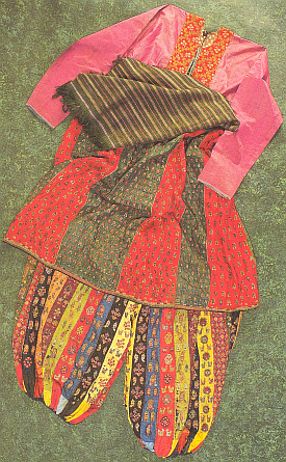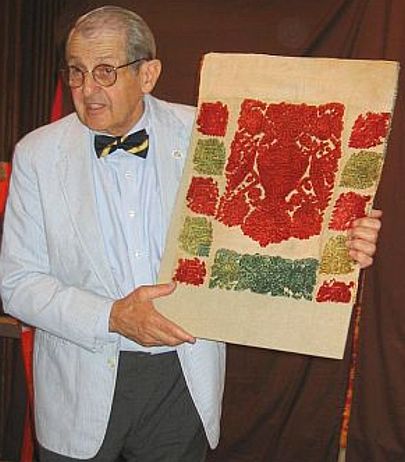Salon du Tapis d'Orient
The Salon du Tapis d'Orient is a moderated discussion group in the manner of the 19th century salon devoted to oriental rugs and textiles and all aspects of their appreciation. Please include your full name and e-mail address in your posting.
Harold Keshishian on Islamic Textiles (Textile Museum, April 15, 2006)
by R. John Howe
Harold Keshishian hosted a "rug and textile" morning program at The Textile Museum in Washington, D.C. on April 15, 2006, with the formidable sounding title, "Islamic Textiles from Turkey, Persia, Syria, The Caucasus, Central Asia and Rumeli." A topic like that likely requires some careful preparation, and here is Harold reviewing his notes

and consulting with Dan Walker, the TM's Director just before he began.

Walker, who gratifyingly frequently attends and participates in the TM "rug and textile"; mornings introduced Harold.

Harold began by explaining his "Rumeli"; reference. Here is a link that gives parallel information:
I took a lot of photos and someone took at set of notes for me. The latter indicate that Harold showed and talked about over 40 pieces. That's too many to treat inclusively here and I don't have good images of all of them, so I will be selective.
One of the early pieces was a late Safavid fragment. Fine red silk with metal.

The piece below was the lower decorated portion of a Persian lady's pantaloon.

Here is a closer look at its designs.

Similar, but distinctive lower pantaloon panels were worn by Zoroastrian ladies. Here is one example from Patricia Baker's, "Islamic Textiles."

Wendel Swan, who owns a Zoroastrian example made this post about such pieces some time back.
I am not entirely sure from either my notes or my memory, but think that Harold said the piece below, a largish panel, was an example of "rasht."

Here is what Peter Stone says about such textiles. "A city of Iran near the southwest coast of the Caspian Sea. It was a source of wall hangings, animal trappings and rugs made of applique or inlaid fabrics and embroidered silk...The Persian term for this work is 'gol-duzi-ye Rasht', 'flower embroidery of Rasht.'
If this characterization of this textile is correct Harold also said that this is one of a pair and that for some reason, items of rasht seem always to have some moth holes.
The small piece below is one justification for Harold's use of the word "Rumeli" in the title of his talk. It is an unfinished Bulgarian lady's cap.

Here is a little closer look.

The next piece Harold had brought was an altar cloth from the Caucasus.

A closer look at its center shows five crosses. It is silk.

Its back is of an older Russian export cotton with an elaborate design.

I am also not entirely sure about the next piece from my notes, but I think that Harold said this piece is a fragment of a bed curtain or cover.

The original was likely about 8 feet long. He indicated that it is most likely from Cyprus or perhaps Crete and has a Venetian double-headed design.
Harold said that piece below is a lovely, graphic item of embroidery from Eperus. It is a lady's undergarment trouser. He said that it is one of the pieces he has collected that he likes most.

Someone ask from the audience whether it was an item that would be seen. Harold smiled and said "Not usually, but perhaps on an appropriate occasion."
Harold ended with three pieces of very different ages.
First, there is a brand new piece that Harold bought out of "Arts and Antiques", magazine from a decorator in LA.

Harold says that it looks very correctly Mugul.
Second, is what he called a period Ottoman piece.


Lots of silver. Composed of 16 scraps.
Third, is a narrow piece either Ottoman or Venitian. Velvet velour and perhaps 400 years old.

I've rotated this piece 90 degrees to the left so you can see a bit more of it.

And here is a last close-up detail in the original orientation.

Last, is a large piece, perhaps French or Swiss and which Harold believes may be as much as 500 years old.

So that is what I can bring you at the moment of Harold's nice TM "textile morning."
Comments and corrections invited.
Regards,
R. John Howe